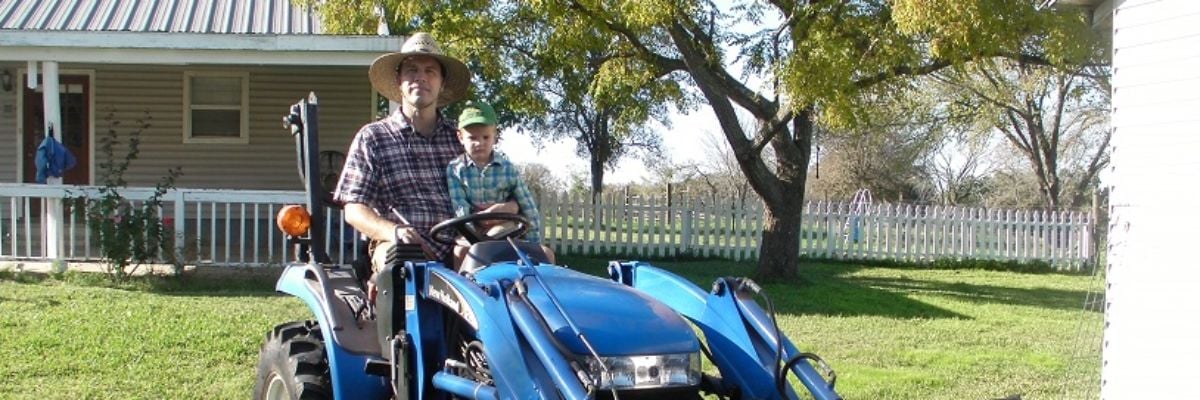
“Imagine evenings sitting on the back porch, watching the sunset,” I told my wife, gesturing grandly. “The cows are grazing; the grass is lush; the air is fresh and clean. And best of all,” I said, “no neighbors within hundreds of yards.”
For years, Katie and I had been thinking about farming. We were attracted by the bucolic images and stories we had read of others who lived on farms, but also by the long history of Catholic agrarianism. Because most Catholics for most of history lived on the land, there was a rich tradition of feasts, customs, seasons, and saints’ days. Sadly, we observe very little of these today. It is difficult, for instance, to have a bonfire in the suburbs to commemorate St. John the Baptist.
We didn’t just dream of farming. We dreamed of helping in some small way to restore these Catholic customs. We hoped to find other Catholic families who shared these dreams, with whom we could work and worship. From our reading, we knew that we could not create a Catholic community ourselves; rather, we needed to find a parish or monastery and center our community of faith around it.
Problem was, when we moved out to our farm, the local small-town parish nearby did not seem very promising in this regard. Very few of the parishioners understood our ideals, let alone shared them. We invited several thriving religious communities to come to our corner of our Texas diocese (a process we initiated with the approval of our bishop and under his guidance). But none of the communities was at a place where it could start a new monastery or convent. So right from the start of our agrarian adventure, the central piece was missing.
Undaunted, we plodded on. Perhaps a monastery will move here eventually, we mused. Meanwhile, to maintain our agricultural tax exemption, we needed animals on our land—lots of them. We could have seven cows or thirty-five goats or 10,000 chickens. It didn’t matter whether we had twenty acres or 20,000. As it was, the property we settled on had just over ten acres, so we chose to go the bovine route.
I had read that you have to project an air of confident dominance over these enormous horned creatures, so as I walked among them the first time, I puffed out my chest and strode manfully around our pasture. For good measure, I carried a big stick with me, just in case they got any ideas. That wasn’t a bad idea, it turns out, because Hildegard, our speckled heifer, decided she was going to challenge the pecking order and started charging at me. I did what any greenhorn suburbanite would do in such a situation: I froze, and then I panicked. But, knowing that if I flubbed this, I’d be done as a cattleman, I mustered enough grit to let out a yell and swing my stick against the ground.
It promptly broke in half. But somehow it was enough to deter Hildegard, and she veered off back to her herd-mates.
After a month or so, the cows had eaten all the grass on our place. We needed to bring in hay, but those large round bales weigh upwards of a thousand pounds. And so began a saga that led to buying a truck, and then a hay buggy for the truck, and then rewiring the trailer connection to try to get the buggy to work, and then buying a tractor so I could just shove and drag the bales around, and finally the tractor tipped over and nearly killed me.
Everything was a “learning experience” out there, and we had enough of them to jump-start my entrance into middle age.
We had moved out to the farm ready to embrace the distributist ideal and relaunch the Catholic Land Movement of early twentieth-century England. Six months into it, we were just hoping the overwhelming amount of work and number of chores would begin to subside even a little. After a year, I injured my back, and I could barely sit at a computer, let alone do farm labor. A year and a half in, we doubled down, bought a milk cow, and quickly learned why everyone said not to buy a milk cow. The milking chores would have been the straw that broke my back, had my back not already been broken. As it was, the disaster that was our milk cow only added insult to injury.
Finally, one evening a few months ago, I said to Katie: “I can do two out of three things well: spend ample time with my family, work to provide for us at my computer job, or be a farmer. But I can’t do all three well; there’s just not enough time in the day. What if we sold the farm and moved back into the city?”
We had not even considered leaving the farm until that moment, but both of us realized then we were done. We put the farm up for sale, got two offers in the first few days, and bought a house back in town next to our old, wonderful parish.
Our grand dream of re-establishing Catholic agrarian life never even came close to becoming a reality, but we don’t regret that we went out to the country and tried it. We learned a great deal—not only about farming, but also about ourselves. And now my children can tell a rat snake from a copperhead and can find all the places where toads like to hide.
Before my subconscious erased all the painful memories of living out in the country, I wrote an e-book chronicling our experiences. Farm Flop: A City Dweller’s Guide to Failing on the Farm in Two Years or Less tells the full story: charging wild pigs, tipping tractors, deadly snakes, escaped cows, country crooks, and finding friends in unexpected places. If you want to read more about our time on the land, check it out!



